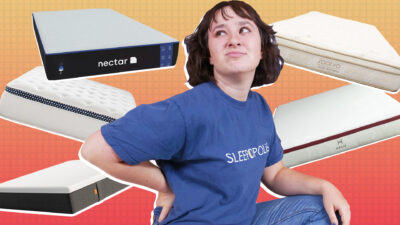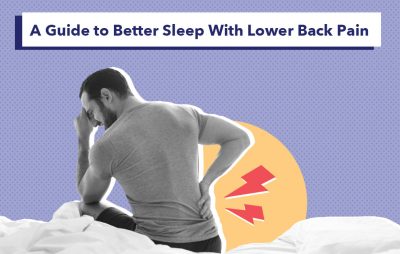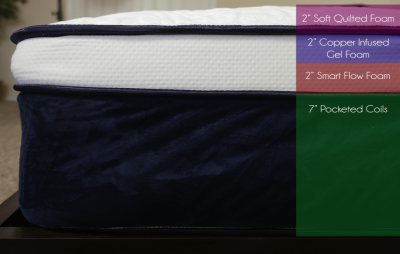Hybrid mattresses aim to create a balanced feel by combining the benefits of foam, coils, and other materials. If you’re a sleeper wanting more than just one type of material, then this type of bed may hit the sweet spot. We’ll give our recommendations for the best hybrid mattresses, and down below we’ll explain the definition of a hybrid mattress. We’ll also review the benefit and touch on the different kinds of mattresses that you’ll find.
Our Top Pick for Hybrid Mattresses
The DreamCloud tops our list because of its balance of comfort and support. It’s an especially excellent pick for lightweight sleepers and back sleepers, has great edge support, and has an incredibly lengthy sleep trial and warranty.
Best Hybrid Mattresses
- DreamCloud – Best Overall Hybrid Mattress
- WinkBed – Best Hybrid Mattress for Back Pain
- Helix Midnight Luxe – Best Hybrid Mattress for Side Sleepers
- Emma Hybrid Comfort – Best Hybrid Mattress for Combination Sleepers
- Saatva – Best Hybrid Mattress for Back Sleepers
- Bear Elite Hybrid – Best Soft Hybrid Mattress
- Titan Plus – Best Hybrid Mattress for Heavy People
- Leesa Sapira Chill – Best Cooling Hybrid Mattress
- Birch Luxe Natural – Best Luxury Hybrid Mattress
Best Hybrid Mattress 2024 Video Review
Comparing the Best Hybrid Mattresses
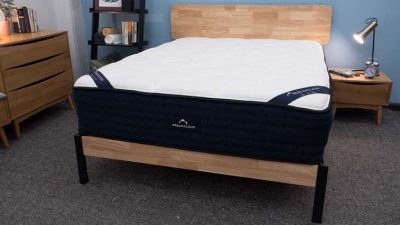
|

|
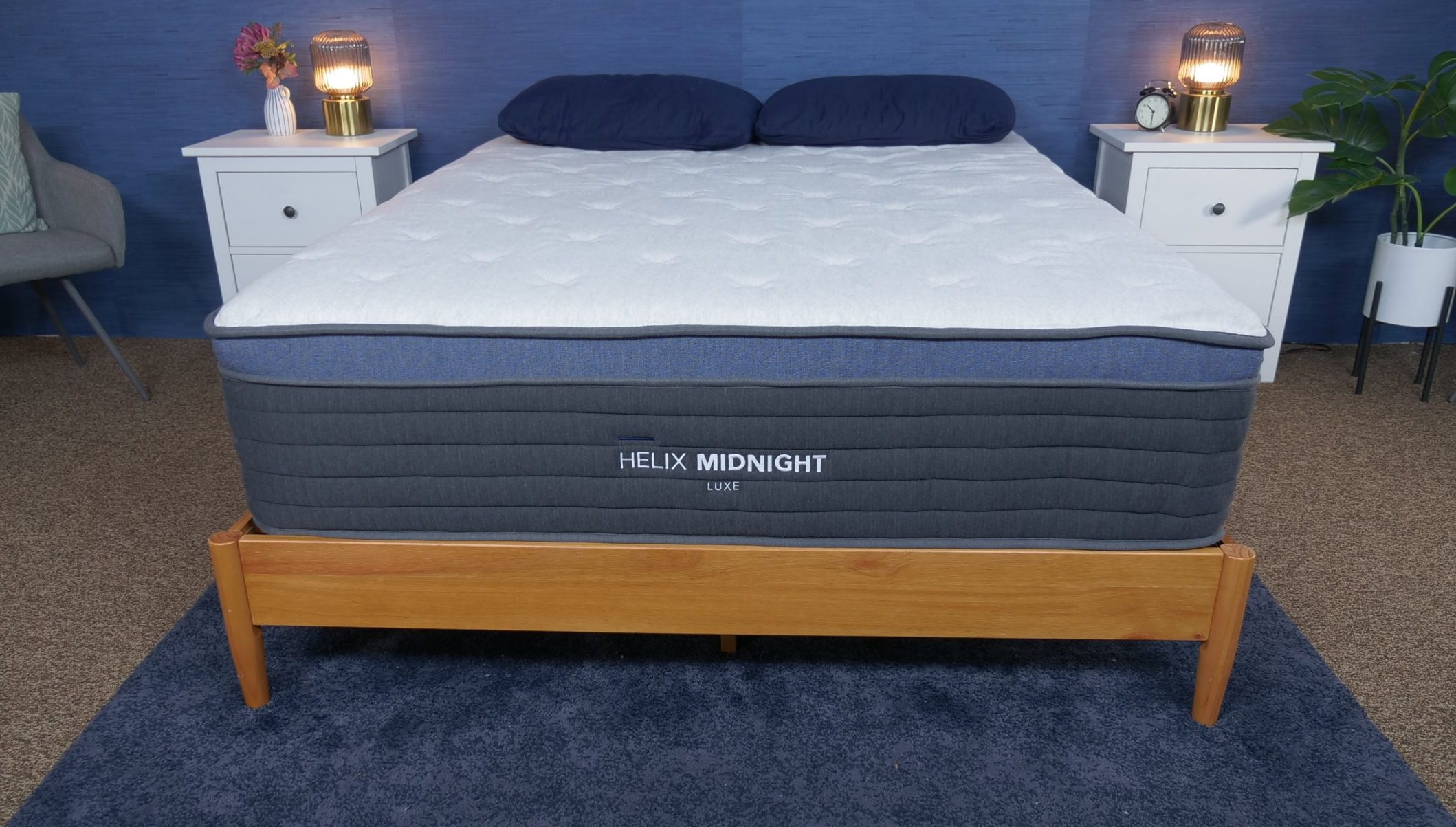
|
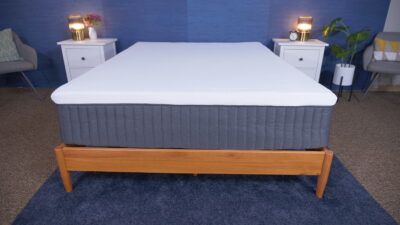
|
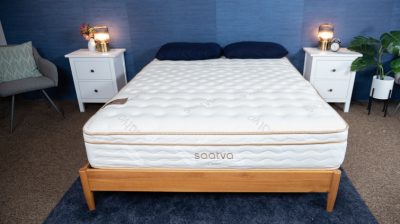
|
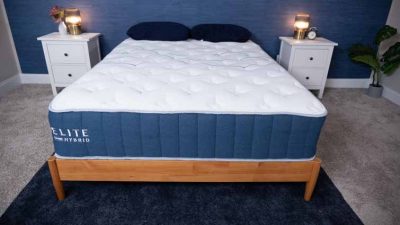
|
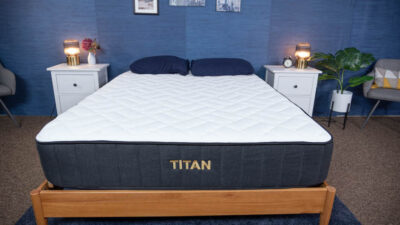
|
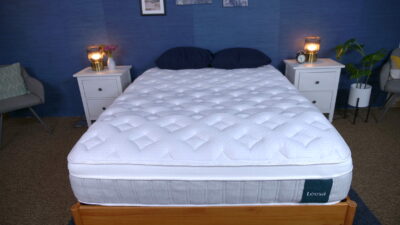
|
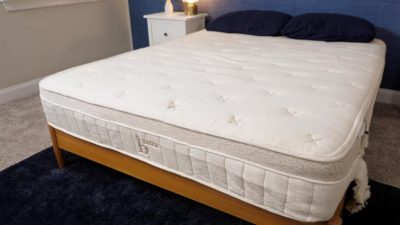
|
|
| DreamCloud Original Mattress | WinkBed Mattress | Helix Midnight Luxe Mattress | Emma Hybrid Comfort | Saatva Mattress | Bear Elite Hybrid Mattress | Titan Plus | Leesa Sapira Chill Hybrid | Birch Luxe Natural Mattress | |
| Rating | |||||||||
| Firmness | Firm: 7/10 | Multiple firmness options | Medium-soft: 6/10 | Firm: 7.5/10 | Multiple firmness options | Multiple firmness options | Firm: 7.5/10 | Multiple firmness options | Firm: 7/10 |
| Material | Hybrid | Hybrid | Hybrid | Hybrid | Innerspring | Hybrid | Hybrid | Hybrid | Hybrid |
| Cooling | ✓ | ✓ | -- | ✓ | ✓ | ✓ | -- | -- | -- |
| Sleep Position | Back | Combination | Combination | Back & Stomach | Back & Stomach | Back & Stomach | Back & Stomach | Combination | Back & Stomach |
What Is a Hybrid Mattress?
A hybrid mattress combines a coil-based foundation with foam layers on the top (typically memory foam or latex foam). This type of bed was created to bridge the gap between coil and foam mattresses, thus meeting the needs of a group of sleepers who weren’t being satisfied by either.
Historically, innerspring/coil mattresses have been known for their support and bounce, while memory foam provides a more pronounced contouring hug and pressure relief. On their own, these two materials are pretty different from one another, but combined, they create a new kind of mattress that brings out the best of each.
DreamCloud – Best Overall Hybrid Mattress
The DreamCloud Mattress is a luxury hybrid mattress made with layers of memory foam and pocketed coils. It offers a great combination of support and pressure relief that back sleepers will really enjoy.
We recommend this mattress for the following sleeper types: Financing options are available for this mattress. I have purchased 5 different Dreamcloud mattresses over the years and never once disappointed. Always fast shipping. Fantastic pricing. But by far the best feature is the quality of the Dreamcloud mattress. Also very impressed with the free bedding (sheets) that came with my recent two purchases. Don’t change what you are doing/offering. It’s perfect in every way.
The DreamCloud Mattress is a luxury hybrid mattress made with layers of memory foam and pocketed coils. It offers a great combination of support and pressure relief that back sleepers will really enjoy.
We recommend this mattress for the following sleeper types: Financing options are available for this mattress. I have purchased 5 different Dreamcloud mattresses over the years and never once disappointed. Always fast shipping. Fantastic pricing. But by far the best feature is the quality of the Dreamcloud mattress. Also very impressed with the free bedding (sheets) that came with my recent two purchases. Don’t change what you are doing/offering. It’s perfect in every way.
The DreamCloud Mattress is a luxury hybrid mattress made with layers of memory foam and pocketed coils. It offers a great combination of support and pressure relief that back sleepers will really enjoy.
We recommend this mattress for the following sleeper types: Financing options are available for this mattress. I have purchased 5 different Dreamcloud mattresses over the years and never once disappointed. Always fast shipping. Fantastic pricing. But by far the best feature is the quality of the Dreamcloud mattress. Also very impressed with the free bedding (sheets) that came with my recent two purchases. Don’t change what you are doing/offering. It’s perfect in every way.
DreamCloud Original Mattress

Material
Hybrid
Trial Period
365 nights
Shipping Method
Free shipping
Firmness
Firm: 7/10
Warranty
Lifetime warranty
Price Range
$$$$$
Hot Sleepers
If you often overheat while you sleep, this mattress should help you stay cool.
Seniors
This bed is perfect for senior sleepers.
Back Sleeping
Ideal for average weight back sleepers.
Financing Options
DreamCloud Original Mattress

Material
Hybrid
Warranty
Lifetime warranty
Firmness
Firm: 7/10
Shipping Method
Free shipping
Trial Period
365 nights
Price Range
$$$$$
Hot Sleepers
If you often overheat while you sleep, this mattress should help you stay cool.
Seniors
This bed is perfect for senior sleepers.
Back Sleeping
Ideal for average weight back sleepers.
Financing Options

DreamCloud Original Mattress
Material
Hybrid
Firmness
Firm: 7/10
Trial Period
365 nights
Warranty
Lifetime warranty
Shipping Method
Free shipping
Price Range
$$$$$
Hot Sleepers
If you often overheat while you sleep, this mattress should help you stay cool.
Seniors
This bed is perfect for senior sleepers.
Back Sleeping
Ideal for average weight back sleepers.
Financing Options
Pros of the DreamCloud Mattress
Soft memory foam for cushioning at the lumbar region and sturdy coils for spinal support
Springs that provide a lot of bounce and responsiveness, both of which help you change positions
Strong edge support, allowing couples to use the whole surface of the bed
Cons of the DreamCloud Mattress
Not enough contouring at the shoulders and hips to be one of the best mattresses for side sleepers
With soft foam and a sturdy layer of innerspring coils, the DreamCloud strikes a balance between comfort and support — a little bit of contouring up top and on-top-of-the-bed feel that comes from the bottom. It’s a fairly firm mattress that we think is most comfortable for back sleepers. It also has some luxury touches such as a cashmere-blend cover that are reminiscent of a high-end hotel. Learn more in our DreamCloud video review.
What our tester says:
“I really like how luxurious this mattress feels and how it could work for a variety of sleepers. Along with that, I found that the breathable cashmere cover helps the DreamCloud sleep cool throughout the night. Thanks to its medium-firm to firm support, I think the DreamCloud is a durable mattress. It balances support with plenty of pressure relief for back sleepers.” – Bridget Chapman, former Sleepopolis senior product editor
Expert Opinion
During testing, we found the DreamCloud has a cozy cashmere pillow top, plenty of cooling gel-infused memory foam for adequate contouring, and sturdy coils to keep our bodies properly lifted. The combination of coils and comfort foams make it a true hybrid. And its medium-firm construction makes it an incredible option for lightweight sleepers, as well as back sleepers of all body types. Hybrid mattresses can get pricey, as the balance of coils and soft foams results in a durable, quality construction. Luckily, you can find the DreamCloud for well under $1,000 after discounts.
This affordable luxury mattress had some important results while testing. Our nifty pressure map uses body heat to track which areas we put the most pressure on in a given sleeping position. Results that show primarily blue and green around the body indicate lower pressure. Yellow, orange, and red areas indicate progressively higher pressure. The DreamCloud showed especially low pressure relief for back-sleeping (almost entirely blue with almost no green). If you’re a back sleeper with back pain problems, we recommend giving the DreamCloud a try.
What our tester says: “I really like how luxurious this mattress feels and how it could work for a variety of sleepers. Along with that, I found that the breathable cashmere cover helps the DreamCloud sleep cool throughout the night. Thanks to its medium-firm to firm support, I think the DreamCloud is a durable mattress. It balances support with plenty of pressure relief for back sleepers.” – Bridget Chapman, former senior product editor
What Customers Say
Many customers commented that this bed-in-a-box delivered quickly and conveniently. So, if you’re wanting a mattress ASAP, the DreamCloud could be a stellar option.
Pros of the DreamCloud Mattress
- While analyzing its construction, we found the cooling gel infusions in the memory foam layer, as well as the breathable coils, make this a suitable choice for hot sleepers who overheat at night.
- The foams used in this mattress are CertiPUR-US certified, passing rigorous tests for material quality.
- With impressive scores for our tests in edge support, responsiveness, and cooling, this is a solid option for couples.
Cons of the DreamCloud Mattress
- For most strict side sleepers, the DreamCloud’s firmer feel (7/10 on our firmness scale) could cause pressure buildup at the hip and shoulder. This was demonstrated on our pressure map, showing a touch of yellow at these points. See our best mattresses for side sleepers for alternatives.
Intrigued by the DreamCloud? Get the best deal here, or learn more in our full DreamCloud mattress review. Need to do some more looking? Check out more choices for the best mattresses of 2024.
WinkBed – Best Hybrid Mattress for Back Pain
The WinkBed is a hybrid mattress that comes in three firmness levels, so most sleepers should find a model that suits their needs. It could also be a good fit for couples, thanks to reinforced edge support.
We recommend this mattress for the following sleeper types: Financing options are available for this mattress. Absolutely the greatest mattress I've ever slept on. It is soft yet firm in the right spots. Quality is on another level. You get what you pay for.
The WinkBed is a hybrid mattress that comes in three firmness levels, so most sleepers should find a model that suits their needs. It could also be a good fit for couples, thanks to reinforced edge support.
We recommend this mattress for the following sleeper types: Financing options are available for this mattress. Absolutely the greatest mattress I've ever slept on. It is soft yet firm in the right spots. Quality is on another level. You get what you pay for.
The WinkBed is a hybrid mattress that comes in three firmness levels, so most sleepers should find a model that suits their needs. It could also be a good fit for couples, thanks to reinforced edge support.
We recommend this mattress for the following sleeper types: Financing options are available for this mattress. Absolutely the greatest mattress I've ever slept on. It is soft yet firm in the right spots. Quality is on another level. You get what you pay for.
WinkBed Mattress

Material
Hybrid
Trial Period
120 nights
Shipping Method
Free shipping
Firmness
Multiple firmness options
Warranty
Lifetime warranty
Price Range
$$$$$
Hot Sleepers
If you often overheat while you sleep, this mattress should help you stay cool.
Back Pain
This bed is perfect for anyone suffering from back pain.
Back Sleeping
Ideal for lightweight and average weight back sleepers.
Side Sleeping
Ideal for lightweight and average weight side sleepers.
Stomach Sleeping
Ideal for average weight stomach sleepers.
Financing Options
WinkBed Mattress

Material
Hybrid
Warranty
Lifetime warranty
Firmness
Multiple firmness options
Shipping Method
Free shipping
Trial Period
120 nights
Price Range
$$$$$
Hot Sleepers
If you often overheat while you sleep, this mattress should help you stay cool.
Back Pain
This bed is perfect for anyone suffering from back pain.
Back Sleeping
Ideal for lightweight and average weight back sleepers.
Side Sleeping
Ideal for lightweight and average weight side sleepers.
Stomach Sleeping
Ideal for average weight stomach sleepers.
Financing Options

WinkBed Mattress
Material
Hybrid
Firmness
Multiple firmness options
Trial Period
120 nights
Warranty
Lifetime warranty
Shipping Method
Free shipping
Price Range
$$$$$
Hot Sleepers
If you often overheat while you sleep, this mattress should help you stay cool.
Back Pain
This bed is perfect for anyone suffering from back pain.
Back Sleeping
Ideal for lightweight and average weight back sleepers.
Side Sleeping
Ideal for lightweight and average weight side sleepers.
Stomach Sleeping
Ideal for average weight stomach sleepers.
Financing Options
Pros of the WinkBed Mattress
Back sleepers and stomach sleepers should get the support they need
Has a traditional, supportive feel
The WinkBed has cooling capabilities to help people who sleep hot
Sturdy edge support and good motion isolation make this a good choice for couples
Cons of the WinkBed Mattress
It lacks a contouring, slow-sinking feel that most associate with the best memory foam mattresses
It may be too pricey for some, and we recommend these shoppers browse the best mattresses under $1,000
The WinkBed is a luxury hybrid mattress. It has a similarly supportive and sturdy feel to a traditional innerspring mattress, but upgrades like a Euro top and cooling Tencel cover give it a touch of modern luxury. Available in three firmness levels, there is a WinkBed for just about every sleeper. And a responsive and bouncy feel makes it a great pick for combination sleepers. Learn more in our video review.
What our tester says:
“One of my favorite things about the WinkBed is its durability. This is a high-quality mattress that should really stand the test of time. This is great news for any sleeper, but especially nice for heavy people and couples.” – Bridget Chapman, former Sleepopolis senior product editor
Expert Opinion
When recommending a hybrid mattress for back pain, we usually like to find something that has a bit of cushioning for the lumbar region while still offering a lot of support for the spine. We think the WinkBed has both of these traits. At the top, we felt lots of contouring at the lower back from its plush pillow top. At the bottom of the mattress, an extra-tall layer of helix coils kept us lifted and helped the spine stay neutrally aligned.
We should note that the WinkBed comes in three different firmness levels: Softer, Luxury Firm, and Firmer, as well as the WinkBed Plus, which is built for heavy sleepers over 250 pounds. We tested the Luxury Firm, and just to make sure it’s an exceptional match for sufferers of back pain, we ran it through our pressure-map test. When lying down on both our back and our side, we saw almost all blue, with just a little bit of green. This indicates low pressure along the whole body, including the back.
What our tester says: “As you’ll see above, the WinkBed is an especially good fit for sleepers with back pain, with the map almost entirely blue. This indicates low pressure and even weight distribution, which is essential for avoiding soreness in the upper or lower back.” – Bridget Chapman, former senior product editor
What Customers Say
According to reviews, combination sleepers who bought the WinkBed seem to experience ease of movement and no trouble feeling stuck on this mattress.
Pros of the WinkBed Mattress
- Side sleepers should be comfortable on the Soft model, back sleepers should enjoy the Luxury Firm model, and stomach sleepers should get the support they need from the Firmer model.
- The tall layer of coils helps air flow through the WinkBed, which should help it sleep cool throughout the night.
- We found the WinkBed to be responsive and bouncy, making it easy for us to switch sleeping positions.
Cons of the WinkBed Mattress
- Even though the WinkBed should work for a wide variety of sleepers, folks who love an extra-soft feel found in the best memory foam mattresses probably won’t enjoy the WinkBed’s springiness and bounce.
Sold on the WinkBed? Shop here for a great deal, or learn more in our full WinkBed mattress review. Still shopping? Check out more of the best mattresses for back pain.
Helix Midnight Luxe – Best Hybrid Mattress for Side Sleepers
The Helix Midnight Luxe is a supportive mattress that's great for back sleepers. The Midnight Luxe’s thick comfort layer of memory foam provides plenty of pressure relief and contouring while the zoned coils offer a great deal of support.
We recommend this mattress for the following sleeper types: Financing options are available for this mattress. The Helix Midnight Luxe is a supportive mattress that's great for back sleepers. The Midnight Luxe’s thick comfort layer of memory foam provides plenty of pressure relief and contouring while the zoned coils offer a great deal of support.
We recommend this mattress for the following sleeper types: Financing options are available for this mattress. The Helix Midnight Luxe is a supportive mattress that's great for back sleepers. The Midnight Luxe’s thick comfort layer of memory foam provides plenty of pressure relief and contouring while the zoned coils offer a great deal of support.
We recommend this mattress for the following sleeper types: Financing options are available for this mattress.Helix Midnight Luxe Mattress

Material
Hybrid
Trial Period
100 nights
Shipping Method
Free shipping
Firmness
Medium-soft: 6/10
Warranty
15-year warranty
Price Range
$$$$$
Back Sleeping
Ideal for average weight and heavyweight back sleepers.
Side Sleeping
Ideal for average weight and heavyweight side sleepers.
Stomach Sleeping
Ideal for lightweight stomach sleepers.
Financing Options
Helix Midnight Luxe Mattress

Material
Hybrid
Warranty
15-year warranty
Firmness
Medium-soft: 6/10
Shipping Method
Free shipping
Trial Period
100 nights
Price Range
$$$$$
Back Sleeping
Ideal for average weight and heavyweight back sleepers.
Side Sleeping
Ideal for average weight and heavyweight side sleepers.
Stomach Sleeping
Ideal for lightweight stomach sleepers.
Financing Options

Helix Midnight Luxe Mattress
Material
Hybrid
Firmness
Medium-soft: 6/10
Trial Period
100 nights
Warranty
15-year warranty
Shipping Method
Free shipping
Price Range
$$$$$
Back Sleeping
Ideal for average weight and heavyweight back sleepers.
Side Sleeping
Ideal for average weight and heavyweight side sleepers.
Stomach Sleeping
Ideal for lightweight stomach sleepers.
Financing Options
Pros of the Helix Midnight Luxe
It sleeps cool, and its materials are designed to be breathable and cool to the touch
Under $2,000 for a queen, which is a great deal for a luxury mattress
Fans of soft mattresses should love this Helix model, it’s rated 6/10 on our firmness scale, which is softer than average
Cons of the Helix Midnight Luxe
Not firm enough to be the best mattress for stomach sleepers
Won’t be supportive enough for heavier sleepers over 250 pounds. These folks should check out the best mattresses for heavy people
The Helix Midnight Luxe is one of the six mattresses in the Helix Luxe line and is the brand’s take on a medium-firm hybrid mattress. It boasts a great balance of comfort and support, making it a great fit for back sleepers. The memory foam layers also provide some nice pressure relief and contouring that should help side sleepers feel supported on this mattress. If you want to learn more and see if this mattress is a good fit for you, check out our video review.
What our tester says:
“I love that the Helix Midnight Luxe offers solid edge support — you can use the whole bed! It also has great motion isolation, which makes it a nice option for couples.” – Bridget Chapman, former Sleepopolis senior product editor
Expert Opinion
We always love testing out the hybrid models from Helix’s Luxe line. These are luxury upgrades of Helix’s original mattresses, with the Midnight Luxe adding some bells and whistles to the medium-firm Midnight. It’s been outfitted with a pillow top that gives us some immediate relief when we lie down, plus there’s zoned support in the coils, meaning that they’re firmer in certain spots and softer than others.
Both of these features go a long way toward being comfortable for side sleepers. While testing in this position, we felt the pillow top gave us some immediate relief at the shoulders and hips, where side sleepers put the most pressure. And the coils kept the spine a neutral spinal alignment. As with our other mattresses, this was further verified with our pressure map test. There was only blue and green when we laid on our side, telling us that there shouldn’t be any pressure buildup while side sleeping.
What our tester says: “I love that the Helix Midnight Luxe offers extra support in the lumbar region, so you can feel lifted up where it’s really needed and have your spine in alignment. I also think the cushiony pillow top feels so cozy while side and back sleeping.” – Bridget Chapman, former senior product editor
What Customers Say
The plusher pillow top of the luxury version is something many folks seem to enjoy; many note that the comfort layer relieves pressure off of sensitive joints and helps alleviate their joint pain.
Pros of the Helix Midnight Luxe Mattress
- Although it’s a luxury mattress, you can often find a queen size Helix Midnight Luxe for under $2,000 after discounts. That’s a great price for such a luxurious bed.
- You and a partner should enjoy this bed, as it tested really well in important factors for couples. We found stellar edge support and impressive motion isolation in the Midnight Luxe. As pressure-relieving as this mattress is, it’s also responsive enough for sex.
- Back sleepers should also enjoy the Helix Midnight Luxe’s mix of comfort and support, as evidenced by our pressure map test.
Cons of the Helix Midnight Luxe Mattress
- If you’re a larger sleeper who weighs over 250 pounds, you may need a more supportive mattress with reinforced materials. You may want to check out the Helix Plus — the brand’s bed made especially for heavy sleepers.
The standard Helix Midnight often makes it onto our roundup of the best mattresses for side sleepers. If you’re ready to meet this bed, click here to get our best deal. You can also learn more in our full Helix Luxe mattress reviews.
Emma Hybrid Comfort – Best Hybrid Mattress for Combination Sleepers
The Emma Hybrid Comfort is a firm, supportive, and bouncy mattress. A good fit for back sleepers and stomach sleepers, it also has open-celled foam for cooling.
We recommend this mattress for the following sleeper types: Financing options are available for this mattress. The Emma Hybrid Comfort is a firm, supportive, and bouncy mattress. A good fit for back sleepers and stomach sleepers, it also has open-celled foam for cooling.
We recommend this mattress for the following sleeper types: Financing options are available for this mattress. The Emma Hybrid Comfort is a firm, supportive, and bouncy mattress. A good fit for back sleepers and stomach sleepers, it also has open-celled foam for cooling.
We recommend this mattress for the following sleeper types: Financing options are available for this mattress.Emma Hybrid Comfort

Material
Hybrid
Trial Period
365 nights
Shipping Method
Free shipping
Firmness
Firm: 7.5/10
Warranty
10-year warranty
Price Range
$$$$$
Hot Sleepers
If you often overheat while you sleep, this mattress should help you stay cool.
Back Sleeping
Ideal for average weight and heavyweight back sleepers.
Stomach Sleeping
Ideal for lightweight and heavyweight stomach sleepers.
Financing Options
Emma Hybrid Comfort

Material
Hybrid
Warranty
10-year warranty
Firmness
Firm: 7.5/10
Shipping Method
Free shipping
Trial Period
365 nights
Price Range
$$$$$
Hot Sleepers
If you often overheat while you sleep, this mattress should help you stay cool.
Back Sleeping
Ideal for average weight and heavyweight back sleepers.
Stomach Sleeping
Ideal for lightweight and heavyweight stomach sleepers.
Financing Options

Emma Hybrid Comfort
Material
Hybrid
Firmness
Firm: 7.5/10
Trial Period
365 nights
Warranty
10-year warranty
Shipping Method
Free shipping
Price Range
$$$$$
Hot Sleepers
If you often overheat while you sleep, this mattress should help you stay cool.
Back Sleeping
Ideal for average weight and heavyweight back sleepers.
Stomach Sleeping
Ideal for lightweight and heavyweight stomach sleepers.
Financing Options
Pros of the Emma Hybrid Comfort
Great motion isolation makes it a good choice for couples
A bouncy feel makes it easy to move around on
An airy hybrid construction keeps the mattress cool
Cons of the Emma Hybrid Comfort
Too firm for side sleepers, who won’t receive adequate pressure relief on the shoulder and hip. We suggest looking at the best mattresses for side sleepers instead
Edge support didn’t impress us — you may not feel supported if you sit or lie along the edge. Some of our favorite options for edge support are in our best mattresses that won’t sag roundup
The Emma Hybrid Comfort is a firm mattress with a durable hybrid construction. It works well for heavyweight stomach and back sleepers, as it provides enough support to keep these sleepers’ spines in neutral alignment. In addition to making it a good choice for heavier people, the Emma Hybrid Comfort’s design also gives it nice breathability and responsiveness, meaning it stays cool as you sleep and is easy to move around on.
What our tester says:
“After five minutes of lying on the Emma Hybrid Comfort, it increased 7.7 degrees. This indicates good temperature regulation. I really did feel cool when resting on it. Considering this, the airy hybrid construction, and the additional cooling features, I feel that the Emma Hybrid Comfort is one of the best cooling mattresses.” – Amelia Jerden, senior staff writer
Expert Opinion
The Emma Hybrid Comfort is an ultra-sturdy mattress that we think could work for a lot of different sleepers — especially combination sleepers. When lying down on it, we found that we were easily able to roll around and switch positions without feeling stuck in the bed. We attribute this to the mattress’s durable support layer of coils.
On our pressure map test, the Emma Hybrid Comfort showed very low pressure buildup in the back sleeping position, so it should contour nicely to the lower back while still supporting the hips. While side sleeping, we did find a bit of yellow, indicating moderate pressure buildup, so we don’t recommend it for these folks if they have hip pain or solely sleep on their side. Given this mattress’s firmness, we also feel comfortable recommending it to stomach sleepers.
What our tester says: “Based on our tests, the Emma Comfort Hybrid Mattress is very responsive, so you’ll have no problems moving around on it.” – Amelia Jerden, senior staff writer
What Customers Say
Despite the bed’s bounciness, many shoppers have noted that the Emma Hybrid Comfort isolates their partner’s movements well, so they aren’t waking up as often because of them.
Pros of the Emma Hybrid Comfort Mattress
- The high-density foams and reinforced edge offer plenty of stability for heavy sleepers over 250 pounds. We felt stable while sitting and lying down on the perimeter of the Hybrid Comfort.
- As it tested well for responsiveness, we feel the Emma Hybrid Comfort is a suitable mattress for sex. And those sleeping with someone who moves around a lot should appreciate the bed’s motion isolation. Sleepers shouldn’t be able to feel their partner’s movement.
- Even average weight back and stomach sleepers should be comfortable on the Emma Hybrid Comfort, getting the support they need to keep their spines neutrally aligned.
Cons of the Emma Hybrid Comfort Mattress
- Since this is an extra-durable mattress, lightweight sleepers likely won’t compress the layers enough to get the pressure relief they need.
Click here for the best deal, or learn more in our full Emma Hybrid Comfort mattress review. You can also see our best mattresses for combination sleepers to keep exploring.
Saatva Classic – Best Hybrid Mattress for Back Sleepers
The Saatva’s coil-on-coil construction provides a classic innerspring feel. It's a good option for combo sleepers, who will want to feel free to switch positions and avoid feeling “stuck” in the mattress. It comes in three firmness levels, so you should be able to find one that suits your needs.
We recommend this mattress for the following sleeper types: Financing options are available for this mattress. We were skeptical of buying a mattress on line but it could not have gone any smoother. Anthony answered all of our questions during our many phone conversations. Delivery was prompt and went without a hitch. Best of all the mattress is so comfortable! I haven't had such a good night sleep in years. Highly recommend this.
The Saatva’s coil-on-coil construction provides a classic innerspring feel. It's a good option for combo sleepers, who will want to feel free to switch positions and avoid feeling “stuck” in the mattress. It comes in three firmness levels, so you should be able to find one that suits your needs.
We recommend this mattress for the following sleeper types: Financing options are available for this mattress. We were skeptical of buying a mattress on line but it could not have gone any smoother. Anthony answered all of our questions during our many phone conversations. Delivery was prompt and went without a hitch. Best of all the mattress is so comfortable! I haven't had such a good night sleep in years. Highly recommend this.
The Saatva’s coil-on-coil construction provides a classic innerspring feel. It's a good option for combo sleepers, who will want to feel free to switch positions and avoid feeling “stuck” in the mattress. It comes in three firmness levels, so you should be able to find one that suits your needs.
We recommend this mattress for the following sleeper types: Financing options are available for this mattress. We were skeptical of buying a mattress on line but it could not have gone any smoother. Anthony answered all of our questions during our many phone conversations. Delivery was prompt and went without a hitch. Best of all the mattress is so comfortable! I haven't had such a good night sleep in years. Highly recommend this.
Saatva Mattress

Material
Innerspring
Trial Period
365 nights
Shipping Method
Free white glove delivery
Firmness
Multiple firmness options
Warranty
Lifetime warranty
Price Range
$$$$$
Hot Sleepers
If you often overheat while you sleep, this mattress should help you stay cool.
Back Pain
This bed is perfect for anyone suffering from back pain.
Back Sleeping
Ideal for lightweight, average weight, and heavyweight back sleepers.
Stomach Sleeping
Ideal for lightweight and average weight stomach sleepers.
Financing Options
Saatva Mattress

Material
Innerspring
Warranty
Lifetime warranty
Firmness
Multiple firmness options
Shipping Method
Free white glove delivery
Trial Period
365 nights
Price Range
$$$$$
Hot Sleepers
If you often overheat while you sleep, this mattress should help you stay cool.
Back Pain
This bed is perfect for anyone suffering from back pain.
Back Sleeping
Ideal for lightweight, average weight, and heavyweight back sleepers.
Stomach Sleeping
Ideal for lightweight and average weight stomach sleepers.
Financing Options

Saatva Mattress
Material
Innerspring
Firmness
Multiple firmness options
Trial Period
365 nights
Warranty
Lifetime warranty
Shipping Method
Free white glove delivery
Price Range
$$$$$
Hot Sleepers
If you often overheat while you sleep, this mattress should help you stay cool.
Back Pain
This bed is perfect for anyone suffering from back pain.
Back Sleeping
Ideal for lightweight, average weight, and heavyweight back sleepers.
Stomach Sleeping
Ideal for lightweight and average weight stomach sleepers.
Financing Options
Pros of the Saatva Mattress
With three firmness options, most sleepers should find a Saatva model that works for them
The Saatva uses high-quality materials that will last you a long time
Its bouncy and responsive feel means it’s great for combination sleepers
The Saatva’s reinforced edges give it some of the best edge support we’ve ever seen
Cons of the Saatva Mattress
If you’re looking for lots of sinkage or amazing motion isolation, you’re better off with one of the best memory foam mattresses
None of the Saatva Classic models will likely be supportive enough for heavy stomach sleepers. For these folks, we recommend the Saatva HD
The Saatva’s coil-on-coil construction provides a classic innerspring feel. It’s a good option for combo sleepers, who will want to feel free to switch positions and avoid feeling “stuck” in the mattress. It comes in three firmness levels, so you should be able to find one that suits your needs. The white glove delivery Saatva provides is an added perk and will save you the headache of getting rid of your old mattress (they take it away for free!). For more information, watch our video review.
What our tester says:
“I thought the Saatva was super easy to move around on thanks to its coil layers and cushiony foam top. I found the Luxury Firm model to have a very supportive, yet plush feel that kept me comfortable in multiple sleep positions.” – Bridget Chapman, former Sleepopolis senior product editor
Expert Opinion
Because it has a coil-on-coil construction, we had a feeling the luxury hybrid Saatva would be an extremely supportive mattress. When we laid down on our back, we could feel the multiple layers of springs keeping the spine supported. At the same time, the lumbar region got some contouring from the bed’s three-inch pillow top.
Of course, we had to put this mattress to the test and get some hard data to back up our suspicions. So we rolled out our pressure map while back sleeping on the Luxury Firm version. What we found is that back-sleeping only causes light pressure buildup at the hips, showing that the Saatva should be a really comfortable choice for these folks.
What our tester says: “I think the Saatva is a great option for back sleepers, as the Luxury Firm model provides enough cushioning for their lumbar region, but also lots of support to keep their spine in a neutral alignment.” – Bridget Chapman, former senior product editor
What Customers Say
One of our favorite parts about Saatva as a company also happens to be one of the customers’ favorite parts: the delivery process. With your mattress purchase, Saatva will set up your new bed and remove your old model for free. This is especially useful if you’re unable to carry a heavy mattress, or if you simply don’t have the time.
Pros of the Saatva Mattress
- The Saatva is available in three different firmness levels (Plush Soft, Luxury Firm, and Firm), so back sleepers, side sleepers, and stomach sleepers alike should be able to find a model that suits them.
- Because there are so many coils, there’s a lot of space inside the Saatva for air to flow through and keep you cool.
- We think back sleepers over 250 pounds should find the support they need on the Saatva. However, larger stomach sleepers and side sleepers over 250 pounds may want to check out the Saatva HD — Saatva’s bed designed specifically for larger people.
Cons of the Saatva Mattress
- During testing, we determined that the innerspring feel of the Saatva creates a lot of motion transfer. So, if you sleep with a partner and either one of you is easily woken up, the Saatva may not be the mattress for you. Our roundup of the best mattresses for couples should offer plenty of outstanding alternatives.
Sold on the Saatva? Shop here for a great deal and learn more in our full Saatva mattress review. Still shopping? Check out more of our favorite mattresses.
Bear Elite Hybrid – Best Soft Hybrid Mattress
The Bear Elite Hybrid is Bear's “ultra-luxurious” model with a traditional mattress feel, plus advanced cooling and support technology. It comes in three different firmness levels: Soft, Medium, and Firm.
We recommend this mattress for the following sleeper types: Financing options are available for this mattress. Love it! I absolutely love this mattress and the adjustable frame. It’s helping my back issues so much. I highly recommend this mattress to anyone with back pain
The Bear Elite Hybrid is Bear's “ultra-luxurious” model with a traditional mattress feel, plus advanced cooling and support technology. It comes in three different firmness levels: Soft, Medium, and Firm.
We recommend this mattress for the following sleeper types: Financing options are available for this mattress. Love it! I absolutely love this mattress and the adjustable frame. It’s helping my back issues so much. I highly recommend this mattress to anyone with back pain
The Bear Elite Hybrid is Bear's “ultra-luxurious” model with a traditional mattress feel, plus advanced cooling and support technology. It comes in three different firmness levels: Soft, Medium, and Firm.
We recommend this mattress for the following sleeper types: Financing options are available for this mattress. Love it! I absolutely love this mattress and the adjustable frame. It’s helping my back issues so much. I highly recommend this mattress to anyone with back pain
Bear Elite Hybrid Mattress

Material
Hybrid
Trial Period
120 nights
Shipping Method
Free shipping
Firmness
Multiple firmness options
Warranty
Lifetime Warranty
Price Range
$$$$$
Hot Sleepers
If you often overheat while you sleep, this mattress should help you stay cool.
Back Sleeping
Ideal for lightweight, average weight, and heavyweight back sleepers.
Stomach Sleeping
Ideal for lightweight and average weight stomach sleepers.
Financing Options
Bear Elite Hybrid Mattress

Material
Hybrid
Warranty
Lifetime Warranty
Firmness
Multiple firmness options
Shipping Method
Free shipping
Trial Period
120 nights
Price Range
$$$$$
Hot Sleepers
If you often overheat while you sleep, this mattress should help you stay cool.
Back Sleeping
Ideal for lightweight, average weight, and heavyweight back sleepers.
Stomach Sleeping
Ideal for lightweight and average weight stomach sleepers.
Financing Options

Bear Elite Hybrid Mattress
Material
Hybrid
Firmness
Multiple firmness options
Trial Period
120 nights
Warranty
Lifetime Warranty
Shipping Method
Free shipping
Price Range
$$$$$
Hot Sleepers
If you often overheat while you sleep, this mattress should help you stay cool.
Back Sleeping
Ideal for lightweight, average weight, and heavyweight back sleepers.
Stomach Sleeping
Ideal for lightweight and average weight stomach sleepers.
Financing Options
Pros of the Bear Elite Hybrid
Thick comfort layers provide lots of pressure relief while coils lift the hips for spinal support
The Medium model has a medium-soft feel that should suit most back and side sleepers
A responsive feel makes this bed easy to move on
Cons of the Bear Elite Hybrid
Heavyweight stomach sleepers won’t get enough support. See our best mattresses for heavy people for better options
As a luxury mattress with many special features, the Bear Elite Hybrid is priced higher. Budget shoppers may want to check out the best cheap mattresses instead
The Bear Elite Hybrid uses foam and coils for a mix of support, cushioning, and cooling. While designed for athletes prioritizing wellness and recovery, sleepers of all activity levels can enjoy the many luxurious features. Enjoy zoned support for targeted relief, an “on top of” feel allowing for ease of movement, and cooling features throughout. For more information, watch our video review.
What our tester says:
“I tested the Medium model and found that it’s a good match for most average-weight back and side sleepers. It has a balanced foam feel, and it offers a good blend of comfort and support.” – Bridget Chapman, former Sleepopolis senior product editor
Expert Opinion
Hybrid mattresses come in all sorts of firmnesses, but if you’re really wanting a softer feel with no shortage of contouring and pressure relief, the Bear Elite Hybrid is for you. Of course, Bear didn’t sacrifice support while constructing this mattress; there’s a sturdy layer of individually wrapped coils that kept our hips lifted and in proper alignment while testing.
After examining the Medium model in our mattress lab, we can confidently say that the cushy cover and double foam layers in this bed should appeal to many side sleepers, as well as those with joint pain. Our pressure map showed little pressure in the side-sleeping position, so no traces of yellow, orange, or red. We think the Soft model could also be a great option for side sleepers looking for even more plushness and sinkage.
What our tester says: “Below the cover is a layer of copper-infused memory foam. This material has a slow response to pressure, providing the sleeper with some immediate comfort and body-contouring. You’re likely to sink into this layer, which could be great for those in need of cushiony support at the shoulders. The copper infusion also helps prevent this layer from trapping body heat.” – Bridget Chapman, former senior product editor
What Customers Say
Many have positive things to say about Bear’s customer service, even when it comes to processing returns and refunds.
Pros of the Bear Elite Hybrid Mattress
- In our lab, we noticed that Celliant — the material in the Bear’s cover — is a great material for cooling. There are also breathable coils and copper-infused memory foam that help with bringing down the body temperature of hot sleepers.
- Celliant is also believed by some to assist with athletic recovery and soothing sore joints and muscles. We can’t confirm this one way or the other, but athletes should at least appreciate how well the Bear Elite Hybrid cools them down after a rigorous workout.
- Back sleepers who are lighter in weight should receive the proper balance of comfort and support.
Cons of the Bear Elite Hybrid Mattress
- The Bear Elite Hybrid (in the Soft model) isn’t firm enough for stomach sleepers. We recommend they check out the Bear Elite Hybrid’s Firm model, or our list of the best mattresses for stomach sleepers for other options.
Did this athlete-focused mattress grab your attention? Get the best deal here. You can also learn more in our full Bear Elite Hybrid mattress review. Still shopping? Read more about our other picks for the best soft mattresses.
Titan Plus – Best Hybrid Mattress for Heavy People
The Titan Firm Hybrid from Brooklyn Bedding is a durable mattress featuring 6-inch heavy-duty support coils, making it a great option for heavier sleepers. This mattress also has a Titanflex foam comfort layer, which provides nice lift and bounce for heavier weights.
We recommend this mattress for the following sleeper types: Financing options are available for this mattress. Get this bed right now! Simply amazing. Does not sag in the middle at all. Best sleep I've had in a very long time.
The Titan Firm Hybrid from Brooklyn Bedding is a durable mattress featuring 6-inch heavy-duty support coils, making it a great option for heavier sleepers. This mattress also has a Titanflex foam comfort layer, which provides nice lift and bounce for heavier weights.
We recommend this mattress for the following sleeper types: Financing options are available for this mattress. Get this bed right now! Simply amazing. Does not sag in the middle at all. Best sleep I've had in a very long time.
The Titan Firm Hybrid from Brooklyn Bedding is a durable mattress featuring 6-inch heavy-duty support coils, making it a great option for heavier sleepers. This mattress also has a Titanflex foam comfort layer, which provides nice lift and bounce for heavier weights.
We recommend this mattress for the following sleeper types: Financing options are available for this mattress. Get this bed right now! Simply amazing. Does not sag in the middle at all. Best sleep I've had in a very long time.
Titan Plus

Material
Hybrid
Trial Period
120 nights
Shipping Method
Free shipping
Firmness
Firm: 7.5/10
Warranty
10-year warranty
Price Range
$$$$$
Back Pain
This bed is perfect for anyone suffering from back pain.
Back Sleeping
Ideal for heavyweight back sleepers.
Stomach Sleeping
Ideal for heavyweight stomach sleepers.
Financing Options
Titan Plus

Material
Hybrid
Warranty
10-year warranty
Firmness
Firm: 7.5/10
Shipping Method
Free shipping
Trial Period
120 nights
Price Range
$$$$$
Back Pain
This bed is perfect for anyone suffering from back pain.
Back Sleeping
Ideal for heavyweight back sleepers.
Stomach Sleeping
Ideal for heavyweight stomach sleepers.
Financing Options

Titan Plus
Material
Hybrid
Firmness
Firm: 7.5/10
Trial Period
120 nights
Warranty
10-year warranty
Shipping Method
Free shipping
Price Range
$$$$$
Back Pain
This bed is perfect for anyone suffering from back pain.
Back Sleeping
Ideal for heavyweight back sleepers.
Stomach Sleeping
Ideal for heavyweight stomach sleepers.
Financing Options
Pros of the Titan Plus
Heavy sleepers should find this mattress comfortable and supportive
It isolates motion well, so couples shouldn’t disturb each other as they move around on it
It’s responsive, so combination sleepers should move around easily on it
It’s durable and has great edge support — it should last for many years
Cons of the Titan Plus
Lightweight sleepers probably won’t get any pressure relief or contouring, so they might be better off with one of the best mattresses for lightweight sleepers
It doesn’t provide the best cooling benefits, unless you add the cooling cover for an extra cost. See the best cooling mattresses for more cooling options
The Titan Plus mattress is a durable mattress made with heavy sleepers in mind. It’s a firm and features heavy-duty coils and Titanflex foam that makes it bouncy and easy to move around on. But it still offers low motion transfer across the surface, so you shouldn’t feel disturbed by a partner or pet moving. The Titan Plus sleeps hotter than some hybrid mattresses, but the brand offers a cooling cover for an additional cost. For more information on the Titan Plus, check out our video review.
What our tester says:
“It’s not often you can find a bed that works for all sleeping positions, but the Titan Plus delivers this for heavy sleepers. I think it’d be a great fit for heavy combination sleepers or couples who are looking for support without sacrificing pressure relief.” – Bridget Chapman, former Sleepopolis senior product editor
A Note On Weight and Body Type
We recognize that people come in all shapes and sizes, and people of every size deserve a mattress that works for their body type. We use the weight categories light, average, and heavy to more easily categorize sleepers based on how mattresses will perform for their body type, as most mattresses are designed for the group we call “average” (130 to 250 pounds). We consider heavy sleepers to be anyone over 250 pounds, and they tend to need more support to prevent them from sinking too far into the layers.
Expert Opinion
Because Brooklyn Bedding designed the Titan Plus for heavy sleepers over 250 pounds, we brought in Paulie, a professional power lifter, to test out the mattress. Although average-weight sleepers are likely to experience the Titan Plus as a firmer mattress, he felt himself sinking into the top layer slightly and getting some soothing pressure relief at his shoulders. But he never sank in too far; the six-inch layer of individually wrapped coils kept him lifted and supported.
On our pressure map test, the Titan Plus worked especially well in the back sleeping position. While there was a little bit pressure buildup shown from our average-weight tester in the side sleeping position, heavier people might receive the proper amount of contouring, so long as they don’t struggle with severe joint pain.
What our tester says: “Heavier sleepers can obtain sufficient pressure relief with the two inches of a latex alternative foam that’s still responsive enough to help keep the body lifted and in proper alignment.” – Bridget Chapman, former senior product editor
What Customers Say
Several shoppers mention that as a heavy sleeper, resting on the stomach makes them feel comfortable and supported.
Pros of the Titan Plus Mattress
- It’s a given that the Titan Plus is the ultimate fit for most heavy sleepers, but average weight back sleepers should get the requisite amount of comfort and support, as long as they enjoy a firm mattress.
- Likewise, average weight stomach sleepers should also be comfortable on the Titan Plus.
- Stemming from our testing results, the Titan Plus is isolates motion really well, and it’s plenty responsive for sex. This leads us to believe that it’s a comfortable mattress for couples over 250 pounds.
Cons of the Titan Plus Mattress
- Side sleepers tend to need more softness and pressure relief than others, so these folks under 250 pounds might find the Titan Plus to be too firm. Check out our best soft mattresses for other options.
If you’re a heavy sleeper, the Titan Plus is sure to give you the support you need. Get our best deal here, or see our full Titan Plus mattress review for more details. Want to explore other options? Check out the rest of our top-rated mattresses for heavy sleepers.
Leesa Sapira Chill – Best Cooling Hybrid Mattress
The Leesa Sapira Chill is a plush, supportive hybrid mattress that comes in three different firmness levels.
We recommend this mattress for the following sleeper types: Financing options are available for this mattress. The Leesa Sapira Chill is a plush, supportive hybrid mattress that comes in three different firmness levels.
We recommend this mattress for the following sleeper types: Financing options are available for this mattress. The Leesa Sapira Chill is a plush, supportive hybrid mattress that comes in three different firmness levels.
We recommend this mattress for the following sleeper types: Financing options are available for this mattress.Leesa Sapira Chill Hybrid

Material
Hybrid
Trial Period
100 nights
Shipping Method
Free shipping
Firmness
Multiple firmness options
Warranty
10-year warranty
Price Range
$$$$$
Back Sleeping
Ideal for lightweight, average weight, and heavyweight back sleepers.
Side Sleeping
Ideal for lightweight and average weight side sleepers.
Stomach Sleeping
Ideal for lightweight and average weight stomach sleepers.
Financing Options
Leesa Sapira Chill Hybrid

Material
Hybrid
Warranty
10-year warranty
Firmness
Multiple firmness options
Shipping Method
Free shipping
Trial Period
100 nights
Price Range
$$$$$
Back Sleeping
Ideal for lightweight, average weight, and heavyweight back sleepers.
Side Sleeping
Ideal for lightweight and average weight side sleepers.
Stomach Sleeping
Ideal for lightweight and average weight stomach sleepers.
Financing Options

Leesa Sapira Chill Hybrid
Material
Hybrid
Firmness
Multiple firmness options
Trial Period
100 nights
Warranty
10-year warranty
Shipping Method
Free shipping
Price Range
$$$$$
Back Sleeping
Ideal for lightweight, average weight, and heavyweight back sleepers.
Side Sleeping
Ideal for lightweight and average weight side sleepers.
Stomach Sleeping
Ideal for lightweight and average weight stomach sleepers.
Financing Options
Pros of the Leesa Sapira Chill
This mattress is versatile — the Medium-Firm model can work for all three sleeping positions
It is offered in three firmness levels, allowing you to find one that works for you
The Leesa Sapira Chill has a cool sleeping surface, a bonus for hot sleepers
Couples should appreciate this bed’s mix of responsiveness and motion isolation
Cons of the Leesa Sapira Chill
It may be too pricey for shoppers searching for the best cheap mattress
It doesn’t offer deep sinkage like the best memory foam mattresses
Leesa doesn’t have the lengthiest trial period or warranty
The Leesa Sapira Chill is a hybrid mattress, available in three firmness levels. We tested the Medium-Firm model and felt it was just softer than average, but could still work for all three sleeping positions — a rare find among mattresses. It also has some effective cooling technology built into it, which helps to keep sleepers cool throughout the night. Learn more in our video review.
What our tester says:
“I really think the medium-firm model is a great fit for all sleeping positions. Yep, the Leesa Sapira Chill is one of those unicorn mattresses that provides a great balance of comfort and support for a wide range of sleepers.” – Bridget Chapman, senior product editor
Expert Opinion
Women going through menopause, people living in hot climates, or anyone who wakes up sweaty can benefit from a cooling mattress. Many beds on the market today have specific technology that helps regulate body temperature, dissipate body heat, and/or wick away moisture. Hybrid mattresses can be effective cooling mattresses, as a combination of cooling foams and breathable coils helps create a comfortable temperature throughout the night.
The Leesa Sapira Chill Hybrid, per its name, was made for cooling. During testing, we took a look at its construction. We cut open the outside of the mattress to reveal cooling gel-infused foam and breathable coils beneath its cooling cover. This means almost every layer in this mattress is dedicated to assisting with cooling. And when we laid down on the mattress cover, we noticed it truly felt cool to the touch.
What our tester says: “Personally, I felt its cooling effects while lying down on it. Considering this, as well as its overall cooling construction, I feel that the Sapira Chill is one of the best cooling mattresses. Also, your body temperature drops when you sleep, so chances are this mattress will have a lower temperature in your home at night.” – Bridget Chapman, former senior product editor
What Customers Say
According to reviews on the Leesa website, customers appreciate the mattress’s Greenguard GOLD certification, as it indicates safe materials and low VOC emissions.
Pros of the Leesa Sapira Chill Mattress
- The Leesa Sapira Chill should be a solid mattress for couples, as it scored at least a 4 out of 5 in motion isolation, edge support, and cooling.
- This mattress is offered in three different firmnesses, so it should accommodate a variety of sleepers. We tested the Medium-Firm version.
- We observed this bed has an “on top of” feel that should appeal to combination sleepers, who frequently change sleeping positions at night.
Cons of the Leesa Sapira Chill Mattress
- This mattress is full of luxury features, and for that reason, it’s not the cheapest bed out there. Luckily, one of the best affordable mattresses might just have you covered.
Is the Leesa Sapira Chill the perfect mattress you’ve been looking for? Click here to get the best deal, or take a deeper dive in our full Leesa Sapira Chill mattress review. Still searching? Check out the rest of our best cooling mattresses.
Birch Luxe Natural – Best Luxury Hybrid Mattress
The Birch Luxe mattress is an eco-friendly and plush hybrid mattress by Helix Sleep. It's designed to sleep cool and assist with muscle recovery.
The Birch Luxe mattress is an eco-friendly and plush hybrid mattress by Helix Sleep. It's designed to sleep cool and assist with muscle recovery.
The Birch Luxe mattress is an eco-friendly and plush hybrid mattress by Helix Sleep. It's designed to sleep cool and assist with muscle recovery.
Birch Luxe Natural Mattress

Material
Hybrid
Trial Period
100 Nights
Shipping Method
Free shipping
Firmness
Firm: 7/10
Warranty
25-year warranty
Price Range
$$$$$
Birch Luxe Natural Mattress

Material
Hybrid
Warranty
25-year warranty
Firmness
Firm: 7/10
Shipping Method
Free shipping
Trial Period
100 Nights
Price Range
$$$$$

Birch Luxe Natural Mattress
Material
Hybrid
Firmness
Firm: 7/10
Trial Period
100 Nights
Warranty
25-year warranty
Shipping Method
Free shipping
Price Range
$$$$$
Pros of the Birch Natural
Organic mattress with numerous GOTS and GREENGUARD Gold certifications
Naturally cooling Talalay latex in its transition layer
Enough firmness and strong support for anyone experiencing back pain
Enough responsiveness for combination sleeping
Ideal for anyone looking for a firmer, more “on top of the bed” feel
Cons of the Birch Natural
This isn’t one of the best mattresses for side sleepers, which have a softer feel that better cushions the joints
Higher price point — one of the best cheap mattresses might be better
You won’t find the slow sinkage many look for in the best memory foam mattress
The Birch Natural is a latex mattress utilizing individually wrapped coils for added support. This mattress specializes in cooling and responsiveness, and the firmer nature suits back and stomach sleepers well. Perhaps the most special part about this mattress is the material quality. Not only is the Birch organic, but it has also earned multiple certifications for safe production and materials. For more information, check out our video review.
What our tester says:
“One of my favorite things about the Birch is how cooling it is. I think any hot sleeper will be satisfied by this breathable bed. It’s definitely one of the most cooling mattresses available thanks to its wool and latex layers. These cooling materials also make it one of my favorite organic mattresses.” – Madison Schaper, Sleepopolis staff writer
Expert Opinion
Just by looking at the Birch Luxe Natural, we can tell that it’s luxurious. Its pillow top and cover made of organic wool and cotton give it an elegant appearance, and when we lie down, we get that lifted, “on-top-of-the-bed” feel we usually associate with high-end hotel mattresses. Even as we’re feeling some pressure relief (especially in my lumbar region), the pocketed coils at the bottom of the mattress are giving us a lot of bounce and support.
What our tester says: “Not only does the Birch Luxe look and feel luxurious, it also features some seriously luxurious materials (I’m talking organic fibers and cashmere). The latex in the bed also helped provide pressure relief, while the individually wrapped coils kept me feeling really supported.” – Bridget Chapman, former senior product editor
What Customers Say
Birch Luxe shoppers are glad the mattress is organic and doesn’t give an off-gassing scent like other mattresses do.
Pros of the Birch Luxe Natural Mattress
- There are a ton of environmentally friendly materials in this mattress, from the organic cotton and wool cover to the natural latex of the comfort layer. We should also note that the latex and the coils help the Birch Luxe sleep cool.
- The springs and latex made the Birch Luxe extremely responsive and bouncy for us, so we think combination sleepers will switch up their sleeping position with ease.
- Back sleepers usually need a supportive bed that still offers at least a little bit of contouring and pressure relief, and from our pressure map results, the Birch Luxe fits the bill.
Cons of the Birch Luxe Natural Mattress
- Side sleepers usually don’t do as well on a firmer, bouncier bed like the Birch Luxe. They’d be better off looking at some of our best pillow top mattresses, which offer enhanced cushioning.
Are you falling in love with the Birch Luxe Mattress? Shop here for a great deal and learn more in our full Birch Luxe Natural mattress review. Still looking for the perfect bed? Check out more of our best luxury mattresses.
Hybrid Mattress Pros and Cons
Let’s cut to the chase. Below, you’ll find a table with the basics. And underneath this section, we’ll break down each of the advantages and disadvantages that hybrid mattresses provide.
| Who Should Buy a Hybrid Mattress | Who Shouldn’t Buy a Hybrid Mattress |
| Side sleepers wanting a blend of contouring at pressure points and spinal support | Memory foam fans seeking a traditional feel |
| Back sleepers chasing a balanced feel | Some couples, specifically sleepers who are easily disrupted during sleep |
| Stomach sleepers looking for firmness and support throughout the night | Budget shoppers searching for the cheapest possible option |
| Combination sleepers needing ease of movement while switching sleeping positions | |
| Hot sleepers who tend to overheat at night | |
| Heavy sleepers needing enhanced durability and support |
Who Should Buy a Hybrid Mattress?
Let’s expand on the above table. I think most sleepers will be happy on a hybrid mattress, and here are some specific bed types that might be preferred by different people:
Side Sleepers
- Side sleepers put the most pressure on their shoulders and hips, so they tend to need a mattress that allows these areas of their bodies to sink into the bed’s layers.
- They should choose a softer hybrid mattress — ideally something with memory foam layers — that offers plenty of pressure relief and contouring.
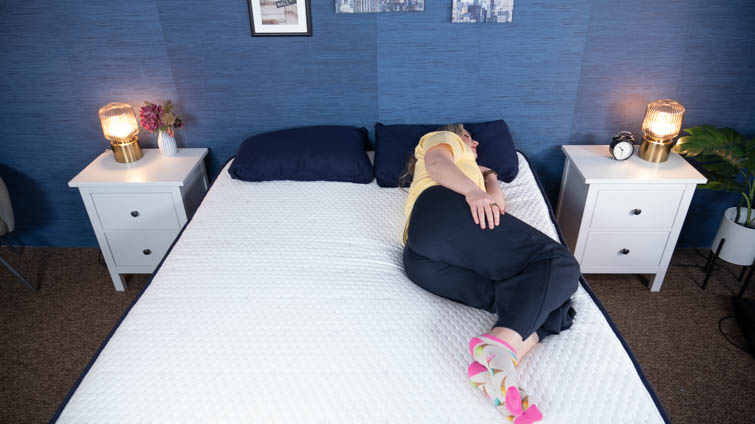
Back Sleepers
- Back sleepers usually need a mattress with a combination of comfort and support — something that offers pressure relief without causing them to sink too far into the bed.
- They’ll likely do best on a medium-firm hybrid. Hybrid beds are great for back sleepers because they provide some nice ergonomic support.
Stomach Sleepers
- Stomach sleepers will need a mattress that keeps their hips in line with their shoulders.
- They should opt for a firm hybrid mattress or an innerspring mattress, both of which should keep them lifted and promote a neutral spinal alignment — a key to preventing back pain.
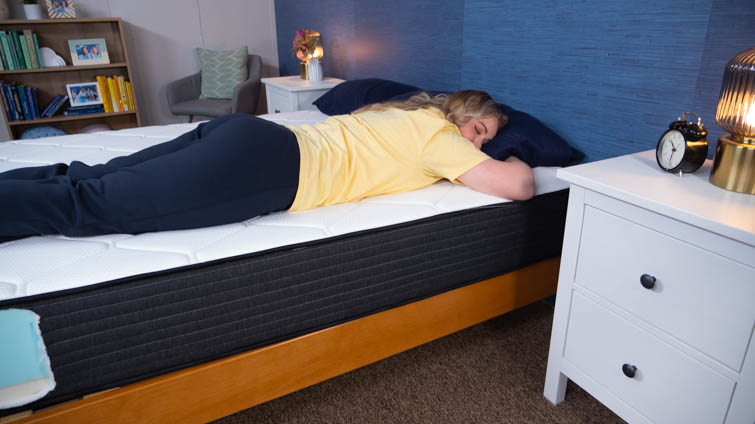
Combination Sleepers
- Because they switch positions at night, combination sleepers will do best on a responsive bed that’s easy to move around on.
- Personally, I’m a big fan of latex hybrid mattresses for combo sleepers.
- I typically steer combination sleepers away from hybrid beds with memory foam layers, as the material makes it more difficult to switch positions.
Hot Sleepers
- People who have a hard time sleeping cool can be quite happy on hybrid beds, as their coil layers help promote airflow.
- If you’re a hot sleeper, look for gel-infused or cooling foam comfort layers, and a breathable cover made from fabrics like cotton, Tencel, or Celliant. If you’re looking for the best cooling hybrid mattress, make sure to check out our best cooling mattresses page for more options.
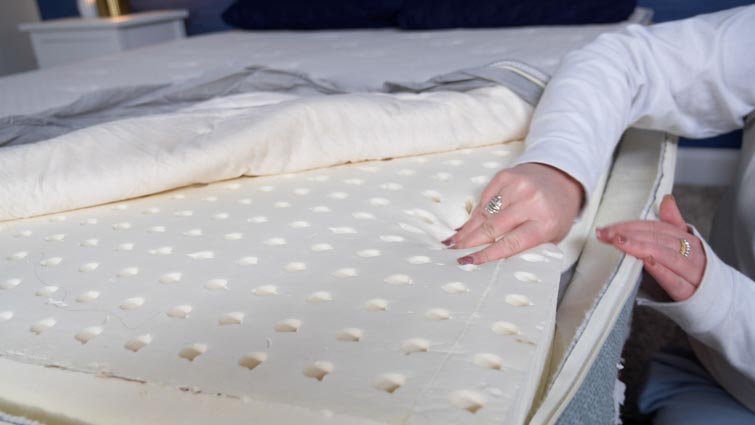
Heavy People
- Heavy sleepers over 250 pounds can do well on hybrid beds. In fact, I’d recommend them as the best option for heavier sleepers, who will want the support from coils and the pressure relief of foam.
- Larger sleepers should look at our best mattresses for heavy people to explore some hybrids specifically designed for plus-size folks.
Who Shouldn’t Buy a Hybrid Mattress?
While hybrid mattresses are extremely versatile options that should appeal to most sleepers, they’re certainly not for everyone.
Memory Foam Fans
- While some hybrids do have thicker foam comfort layers, most options on the market won’t provide that traditional slow-sinking feel associated with
- If you’re determined to get a hybrid but want to come as close as you can to a memory foam feel, I recommend a pillow top mattress like the DreamCloud Premier.
Some Couples
- Since hybrids include coils and tend to have a more responsive feel, not all are good at isolating motion. So, if you sleep with a partner at night and don’t want to feel disturbed by their movements at night, you might want to opt for an all-foam mattress.
- That said, have tested some hybrid beds that do provide a suitable amount of motion isolation, and these often have a thicker comfort layer or some kind of pillow top. The best mattress toppers can also help isolate motion on hybrid beds.
Budget Shoppers
- Because of the added coils, hybrid mattresses are generally priced higher than memory foam mattresses. If you’re looking for a super cheap option, you might be better off with an all-foam bed.
- Still, we recommend you pay attention to overall durability when purchasing a mattress. A mattress that’s too inexpensive can really lack in quality, and even a year of use can cause the foams to sag beneath you.
What is a Hybrid Mattress Made of?
Most hybrid mattresses are made with both coils and foam, merging many of their good qualities while leaving out the negatives. For instance, hybrid mattresses tend to maintain the bounce and ease of motion from the coil-based innerspring mattresses while still providing layers of deep compression support and pressure relief. A true hybrid mattress will only use springs and foams to form all of its layers.
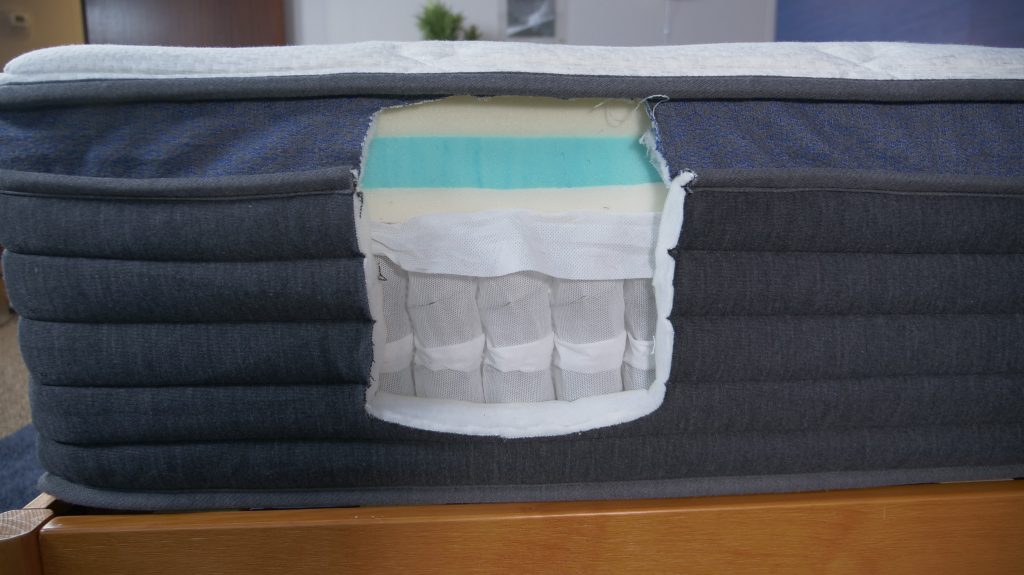
Types of Coils Used in Hybrid Mattresses
- Pocketed Coils: These coils are individually encased in fabric, and are the most commonly used in the sleep industry. They move independently from one another, which means their support is tailored to each person’s body.
- Bonnell Coils: Invented in the 19th century, these hourglass-shaped coils provide both responsiveness and support. The wider part of the coil compresses easily, while the thinner part of the coil is stronger. All of the coils are connected with wires, forming a network of coils called the Bonnell unit. They’re more common in innerspring mattresses than hybrids.
- Continuous Wire Coils: These coils are called “continuous” because they’re composed of a row of coils made from a single wire. The coils have a helical shape and provide consistent support. They’re also known for their affordability and durability.
- Offset Coils: Offset coils are similar to Bonnell coils in shape, but they move more independently to provide individualized support. Additionally, they offer some nice body-contouring support.
What Does Coil Count Mean?
Coil count, unsurprisingly, refers to how many coils are in a mattress.
What to Look for With Coil Count
Typically, you’ll want to avoid mattresses with low coil counts (less than 300), as they won’t offer the same level of support.
These days, you’ll often see coil counts of 1,000 in hybrid mattresses. However, I wouldn’t say this is necessarily an indicator of quality, since you’ll also want to know the coil gauge, which I’ll describe below.
What is Coil Gauge?
A mattress’s coil gauge tells you how firm it will feel. A mattress with a lower coil gauge is going to have thicker coils, which will make the mattress feel firmer. Conversely, a mattress with a higher coil gauge will have thinner coils and feel softer. Typically, coil gauge numbers range from 12 to 15, with 15 being softest and 12 being firmest.
Firm Support or Pressure Relief?
If you’re looking for firm support, I’d recommend a gauge of 13 or lower. If you’re after pressure relief and contouring, you’ll fare better with a gauge of 14 or higher.
Types of Foams Used In Hybrid Mattresses
| Type of Foam | Pros | Cons |
| Polyurethane (poly) foam | Cheap, offers softness and pressure relief | Sometimes lacks in quality |
| Memory foam | Slow response to pressure allows for contouring | Some don’t like the sinking feel that accompanies the best memory foam mattresses |
| Latex foam | Made from eco-friendly Talalay or Dunlop latex, high-quality | Often expensive |
Foam Hybrids
Foam hybrids are a rarer type of hybrid bed, omitting the spring-based coils in favor of a mix of different types of foam. Usually, the foams selected follow a similar pattern to what traditional coil-and-foam hybrids use, where one layer of foam offers more support, bounce, and response, while another layer creates more comfort, contour, and pressure relief.
How do Hybrids Compare to Other Mattress Types?
Wondering how hybrids compare to other popular beds on the market? Check out my comparisons below.
Hybrid vs Innerspring
Like hybrid mattresses, innerspring mattresses are made with coils. However, hybrid mattresses have layers of foam, while innerspring beds typically do not. Innerspring beds tend to have a firmer, more traditional feel than hybrid beds.
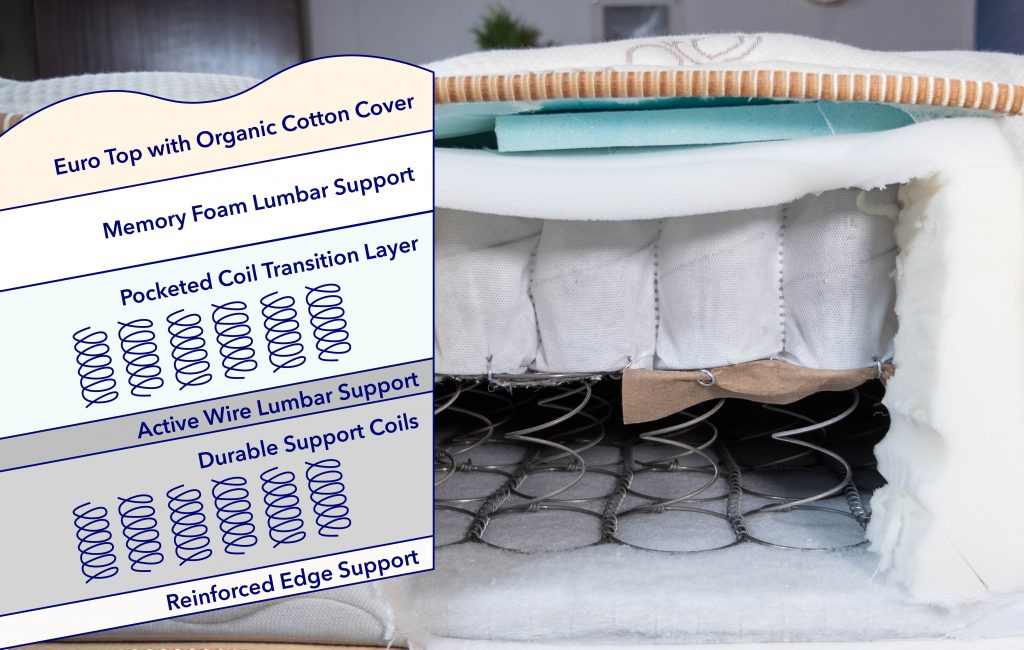
Hybrid vs Foam
While hybrid mattresses use a combination of foams and coils in their constructions, foam mattresses are all-foam. Foam mattresses can be made with poly foam, memory foam, gel memory foam, or proprietary foam. Depending on their construction, they can be firm or soft, and vary in levels of support. All-foam beds tend to be a bit less durable than hybrid or innerspring beds.
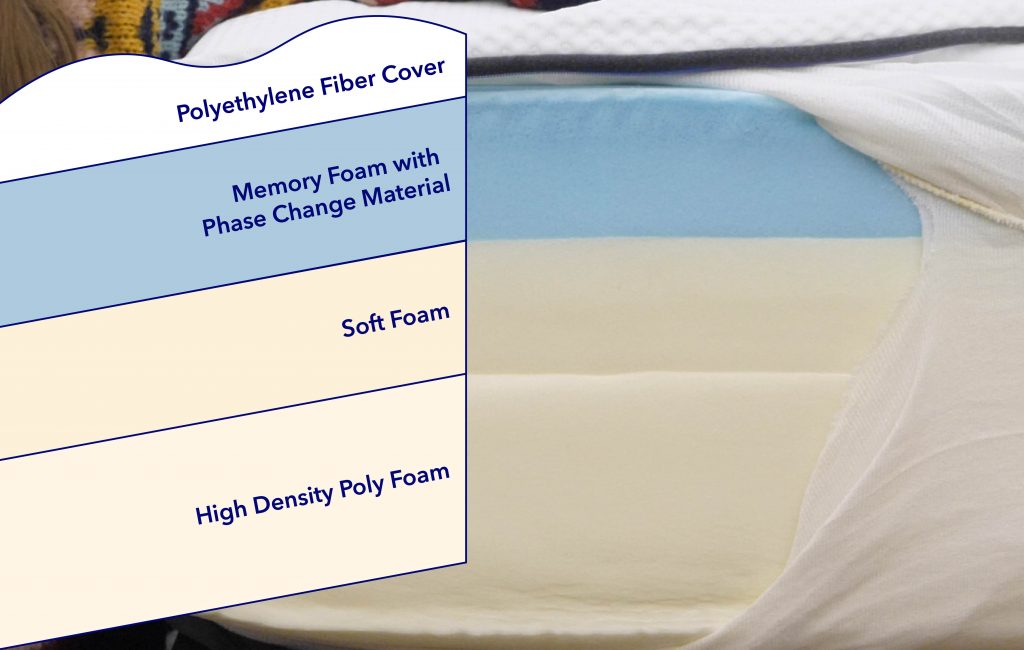
Hybrid vs Latex
Latex can either be synthetic or natural. Natural latex comes from rubber trees. It offers the same pressure relief as other foams, but has a more buoyant feel. It’s also naturally cooling, which makes it a nice option for hot sleepers. Latex mattresses can be hybrids, made with springs and latex foam, or made entirely from latex. Latex beds tend to be more expensive than hybrid, foam, or innerspring beds.
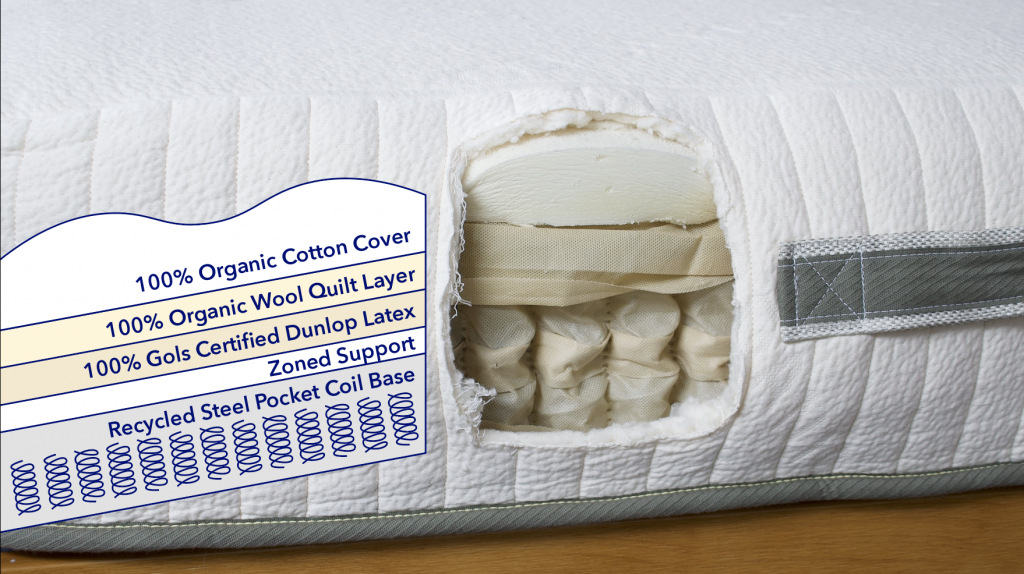
Hybrid Mattress Testing Performance
- Firmness: Hybrid mattresses can have a range of firmness levels, but generally, beds with thicker coil layers tend to feel firmer, while mattresses with more layers of foam feel softer.
- Motion Transfer: Essentially the measure of how much movement you can feel from one side of the bed on the other, motion transfer is an important factor for couples or anyone who sleeps with a pet. Typically, hybrid mattresses have good motion transfer since their foam layers help absorb the bounce of the coils.
- Edge Support: This is especially important for mattress durability, as solid edge support can prevent premature mattress sagging. I’d recommend looking at mattresses that mention edge support in their materials, like a high-density foam edge support layer or edge support coils.
- Lifespan: Hybrid mattresses typically last between seven and 10 years. Their coil layers make them more durable than all-foam mattresses, which I would say wear out the fastest. The average hybrid mattress warranty is around 10 years, so you can expect you’ll need a new bed around that time.
FAQs
What is a hybrid mattress?
A hybrid mattress is any mattress that uses a combination of different materials in its various layers. Most hybrids have one or more layers of memory foam for comfort and a layer of innerspring coils for support. However, they may use other materials such as latex foam.
What is the best hybrid mattress?
Everyone has varying needs and preferences, making this difficult to determine. However, if you’re unsure of what you want, we recommend the Saatva Classic. We’re big fans of its sturdy, supportive construction, luxurious-feeling pillow top, and appreciate that it comes in multiple firmness and height options.
What are the negatives to buying a hybrid mattress?
Because hybrid mattresses include steel coils for durability, they’re often more expensive than all-foam mattresses. Also, these coils add bounce to hybrid mattresses. If you sleep with a partner, this can cause you to feel their movements at night. Others may not like hybrid mattresses because they don’t always offer the same amount of pressure relief and contouring as all-foam mattresses.
Is it better to get a foam or hybrid mattress?
It truly depends on your body type, sleeping position, and personal preferences. Foam mattresses are especially appealing to those who need more pressure relief, such as side sleepers or those with joint pain. Hybrid beds are great for those looking for more support, such as heavier sleepers or stomach sleepers.
Do hybrid mattresses sag over time?
Hybrid mattresses, along with many other mattresses, have the potential to sag over time, as an old and well-worn bed won’t have the same support as a brand-new one. However, hybrid mattresses are less likely to sag than all-foam mattresses, especially if they include quality materials. Many top brands should last shoppers a good 7-10 years.
Can you put a hybrid mattress on a box spring?
Yes, you can put most hybrid mattresses on box springs. We recommend you confirm with your mattress’s manufacturer, but typically, box springs can enhance support and preserve the lifespan of a mattress.
How We Chose These Mattresses
Our team of Certified Sleep Science Coaches has reviewed more than 300 products in our mattress lab, running each one through tests such as pressure-mapping and measuring motion transfer with a seismometer. From there, we give every bed an overall score based on materials, comfort, support, cooling, and edge support. We also factor in brand performance with categories such as value and warranty.
Most people seek out a hybrid mattress because of the unique combination of materials. By relying on a blend of memory foam, latex foam, coils, or something else, hybrids are able to cater to a wide variety of sleepers with different needs. So for this roundup, we started by finding a wide range of products, all with dynamic constructions that use springs and some kind of foam. We then narrowed it down by only selecting mattresses that scored at least a 4 out of 5 in materials. Also, many sleepers love hybrid mattresses because they’re generally more cooling than foam mattresses. So we made sure to stick with beds that scored at least a 4 out of 5 in cooling. Click here to learn more about our methodology.
Best Hybrid Mattresses: Details and Pricing
The majority of hybrid mattresses range from about $1,000 to $2,000 for a queen-size bed. Hybrid beds are typically more expensive than all-foam beds, and their cost depends on factors like quality of materials, thickness of the mattress, extra features such as cooling and athletic recovery, and whether or not the bed was made in the USA.
Many online mattress retailers run promotions that can significantly reduce cost. Holidays like Labor Day, President’s Day, Memorial Day, and Black Friday tend to be some of the best days to buy a new mattress as many brands will run sales on those days.
| Mattress | Best For | Price (Queen) | Coupon | Review |
|---|---|---|---|---|
| DreamCloud | Best Overall | $1,332 | DreamCloud Coupon | Read Our Review |
| WinkBed | Back Pain | $1,799 | WinkBed Coupon | Read Our Review |
| Helix Midnight Luxe | Side Sleepers | $2,374 | Helix Coupon | Read Our Review |
| Emma Hybrid Comfort | Combination Sleepers | $1,199 | Emma Coupon | Read Our Review |
| Saatva | Back Sleepers | $1,995 | Saatva Coupon | Read Our Review |
| Bear Elite Hybrid | Soft | $2,111 | Bear Coupon | Read Our Review |
| Titan Plus | Heavy People | $1,249 | Brooklyn Bedding Coupon | Read Our Review |
| Leesa Sapira Chill | Cooling | $2,159 | Leesa Coupon | Read Our Review |
| Birch Luxe Natural by Helix | Luxury | $3,248 | Helix Coupon | Read Our Review |

